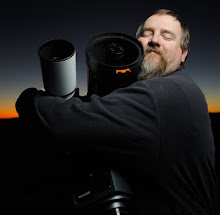A small and very faint comet has surprised observers around the world by overnight becoming bright enough to see with the unaided eye.
Comet Holmes, which was discovered in November 1892 by Edwin Holmes, in London England, was no brighter than magnitude 17 in mid-October—that's about 25,000 times fainter than the faintest star that can normally be seen without any optical aid. In order to view an object this faint, one would need a moderately large telescope.
But the comet's brightness has suddenly rocketed all the way up to 3rd-magnitude, brightening nearly 400,000 times in less than 24 hours! On this astronomers scale, smaller numbers mean brighter objects. From urban locations, a 3rd-magnitude object might be hidden by light pollution, but under rural skies it would be clearly vsiible.
I shot it with all three cameras last night and got the best results with the SPC900C webcam. This is 1000 frames shot through the 10" LX200 @ f/10. It's very close to what I saw in the eyepiece: a bright nucleus, a small fan-shaped "tail" inside a glowing disc. It almost looked like a star seen through dew-covered optics (I checked!). I thought it was sort of greenish in the telescope, but it was yellow to my naked eye, and came out sort of golden here.






No comments:
Post a Comment